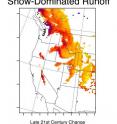Study: Future snowmelt in West twice as early as expected; threatens ecosystems and water reserves
According to a new study, global warming could lead to larger changes in snowmelt in the western United States than was previously thought, possibly increasing wildfire risk and creating new water management challenges for agriculture, ecosystems and urban populations. Researchers, including a Purdue University professor of earth and atmospheric sciences, discovered that a critical surface temperature feedback is twice as strong as what had been projected by earlier studies.
The high-resolution climate model used by the team was better able to reproduce the complex topography of the western United States and capture details of the effect of snow cover on the climate system, as well as the historical record of runoff.
The findings will be published in an upcoming issue of Geophysical Research Letters and are now available online at the journal's Web site.
Noah Diffenbaugh, senior author of the paper and an associate professor of earth and atmospheric sciences at Purdue, said the influence of melting snow on regional climate is far greater than that of increased greenhouse gases alone.
"The heat trapping from elevated greenhouse gases triggers the warming, but the additional warming caused by the loss of snow is what really creates the big changes in surface runoff," said Diffenbaugh, who also is a member of Purdue's Climate Change Research Center. "Scientists have known about this general effect for years. The big surprise here is how much the complex topography plays a role, essentially doubling the threat to water resources in the West."
Sara A. Rauscher, visiting scientist at the Abdus Salam International Centre for Theoretical Physics in Trieste, Italy, and lead author on the paper, said the melting snow contributes to a feedback loop that accelerates warming.
"Because snow is more reflective than the ground or vegetation beneath it, it keeps the surface temperatures lower by reflecting energy from the sun," Rauscher said. "When snow melts or does not accumulate in the first place, more solar energy is absorbed by the ground, warming the surface. A feedback loop is created because the warmer ground then makes it more difficult for snow to accumulate and perpetuates the effect."
The amount and timing of the runoff from snowmelt is critical to the success of water management in the western United States. Water resources for the area are reliant on snow acting as a natural reservoir during the cold season that melts and releases water in the warm season.
Changes in this timing could create problems in meeting the increasing demand for water in large urban and agricultural areas during the hottest summer months, Diffenbaugh said.
"If the snow melts earlier or if it comes as rainfall instead, it would create a strain on infrastructure," he said. "The current system relies on water being stored in the mountains as snow. So earlier runoff could mean too much water for the reservoirs early in the year and not enough available later in the year."
Gregg M. Garfin, deputy director for science translation and outreach at the Institute for the Study of Planet Earth at the University of Arizona, said dry summers could lead to more severe wildfires and changes in the ecosystems of the West.
"Early snowmelt and warmer soil temperatures could result in further massive forest mortality and an increased risk of wildfire activity," Garfin said. "If these projections become reality, then the ecosystems of the northern and central Rockies will undergo dramatic changes with ramifications for wildlife habitat, fire potential, soil erosion and tourism."
The study suggests a substantial change in the runoff season, with the peak date more than two months earlier than today in some regions, Diffenbaugh said.
"During the past 50 years, the peak runoff time has moved 10 to 15 days earlier," he said. "It is not surprising that as we look to the future, the projected changes are much greater than the historical changes. The increase in greenhouse gas emissions has been relatively small for the past 50 years compared with where we are headed over the next several decades if substantial changes in energy technology and population growth do not occur."
The researchers also compared the climate model to historical records and found that it had a high level of agreement with historical data and observed trends.
"One of the most important contributions of this work is the remarkable agreement between the climate model and the observations of the recent past," Diffenbaugh said. "This agreement should increase confidence not only in these particular projections of future changes, but also of climate model projections in general."
Source: Purdue University
Other sources
- Future Snowmelt In West Twice As Early As Expected; Threatens Ecosystems And Water Reservesfrom Science DailyWed, 16 Jul 2008, 0:21:19 UTC
- Study: Future snowmelt in West twice as early as expected; threatens ecosystems and water reservesfrom PhysorgTue, 15 Jul 2008, 20:42:08 UTC
